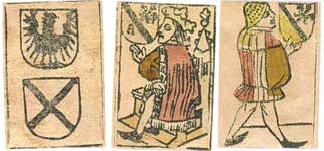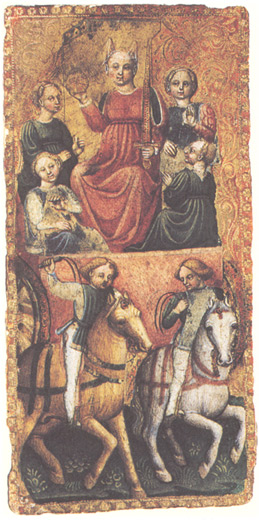|
- The unbelievable good Timeline
The timeline of Trionfi.com has improved considerably and is already at a quite usable stage, although still in development. Tarot and general Playing Cards history are presented in a united form, so that correlations between the both developments are open to research.
Accompanying to the new structure various new web resources are explorable: Master ES, a very early playing card designer from ca. 1460, is presented with various cards, until now not present in the web. 20 of the Duerer Mantegna Tarocchi cards are open to comparison with the 16th century Cologne Mantegna edition. The curious Schäufelein deck from ca. 1535 is now nearly complete. 6 of the Boiardo cards (after 1494), 3 cards of the Aragonese master (ca. 1470), the most important cards of the Flemish Hunting deck (ca. 1470), some unknown cards from the Master of the Bandelore (1460 - 1500) and many other treasures wait for your visit.
Cards from 15th century are rare objects - and very necessary to be known by card researchers, when talking about playing card history. Thanks to the Kaplan Encyclopedia's Tarot Cards from 15th century are more or less all known and good accessible, but the group of normal playing cards are till now not presented with some system, so it's difficult to get them together, and, even when you invest considerable intelligence and good sources, it's difficult to state that you know all of them. So - if you know of some, which aren't mentioned in the Timeline, please inform us.
- Thierry Depaulis expressed recently in a short article in a game magazine ("Le tarot démystifié" in "Tangente jeux", no. 9, Juin-Juillet-Août 2004 pp. 34-37 p. 35 fig. 2.) the opinion, that the single card from Ferrara is part of the same pack as the two cards in the Warsaw museum (information from Ross Caldwell, the Warsaw museum cards are shown in Kaplan Encyclopedia I, p. 109). The note reads - "Fig 2. Le Chariot (copyright) Coll. Musée français de la Carte à jouer, Issy-les-Moulineaux. Discovered in 1988, this atout belongs to a scattered tarot of which we know two other cards in the National museum of Warsaw. This deck was painted in Ferrara around 1455." In our opinion the card shows similarities to the fragmented Chariot card shown on one of the sheets in the Metropolitan Museum Museum of Art (see pictures to the right and short article).
- Rockstar Madonna changed her name to Esther cause of personal interests to Jewish Kabbala. Tarot cards are also involved in her new show. Perhaps we will see soon somebody changing her name to Bianca Maria, Beatrice or Isotta ("three girls, who invented Tarot").
- Judge strikes down fortunetelling ordinance. In the case you don't know it, Tarot card reading is protected by the freedom of speech, freedom of expression and freedom of religion.
- "Totarama", a Punjabi-language play by Mr Sehbai, was completed in 1982 and is a send-up of a society that has invested all its faith in a tarot-telling parrot." Staged in London.
- Hacker attack on reknown Tarot Forum on 27th of June. The hackers claimed political aims connected to the fights in Irak and Palestina. A serious sign for other Tarot web site owners, it seems, that some people perceive them as a possible target of attack.
- Tarot-Webmasters might find Kenaz.com an interesting service, where you can publish your link and make yourself known. The used technique is rather good, but it's a little disappointing, that Kenaz stayed rather unobserved by the active Tarot community.
- Robert M. Place, author of various decks, announced in an interview with Bonnie Cehovet: "In November I have a book coming out called The Tarot: History, Symbolism, and Divination. It is being published by Tarcher, a division of Penguin Putnam and It is my first book that is not connected to one of my decks. It focuses on the Waite-Smith deck and it will have the most complete discussion of my theories on the Tarot that are in print. The publisher plans on it becoming a classic reference for the study of the Tarot."

-
In Tarot News, February 2004, we reported about the claim of the Karnöffelzunft Willisau in Suisse to possess a playing card deck from 1392. As already suspected in February, the real intention was a Carnival's joke - as it could be verified by the page of Simon Wintle, who presents the deck as from ca. 1530, reproduced in 1998.
Well, why not. It was a fair try and it's old custom to make a fool of somebody :-). It is reported from the years 1460 and 1484 already, that Karnöffel influenced the Fastnachtsspiele and that people disguised as figures of the game. In Italy the question how "Trionfi" and "Carnival" influenced each other is quite unsolved, true is, that Lorenzo de Medici was rather ardent about Carnival in the 70ies of 15th century, but Trionfi as festivity and as card game already started in the 40ies of the same century. Which was first? Did playing card games gave origin to Carnival customs? Any more informations from somebody, also about these mysterious Fachtnachtspiele in the Suisse? It's a hot topic for discussion, how Carnival became the phenomen as that it is known. True, some aspects are already well established in the old Roman society, but others seem to develop in relation to Trionfi and Trionfi cards in early renaissance.
 (composed by Huck Meyer) (composed by Huck Meyer)
|
  |

